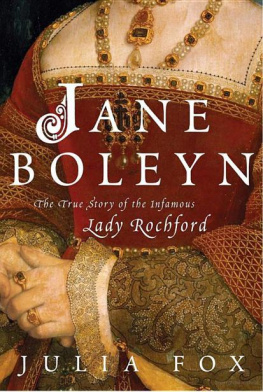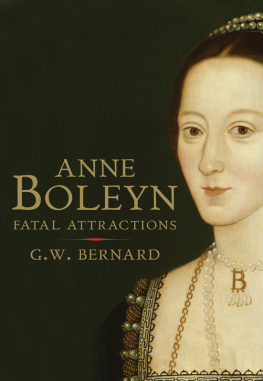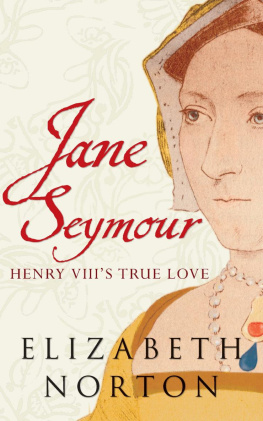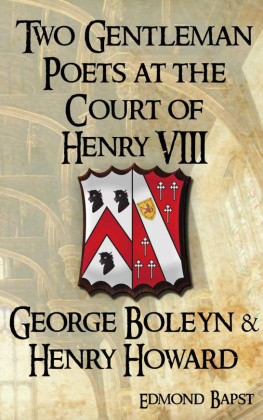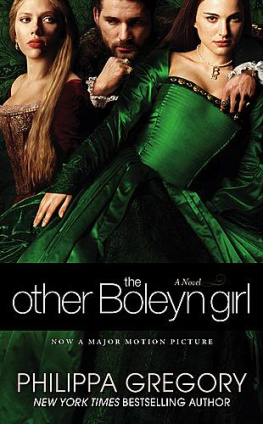ACKNOWLEDGMENTS
Im not sure quite how Jane Boleyn came into my life. She simply did. One moment I was considering a book on Henry VIIIs queens and the next those beguiling ladies were totally sidelined in favor of this woman, a pariah of Tudor history, whom no one had really considered before. I was hooked instantly. And the more I dug through the records, many ignored for centuries, the more obvious it was that Jane Boleyns story was not only just as gripping as those of the queens she had served but that she had been thoroughly maligned. She was no fairy godmother, but she was no wicked witch either. Forced to look out for herself in a mans world, she so nearly succeeded.
No book of this type, however, is a solo effort. I could never have even started without access to the finest scholarship currently available on the reign of Henry VIII. Among that of the many giants of Tudor history, the work of Professor Eric Ives and Dr. David Starkey has proved invaluable. To them, in particular, I owe an immense debt. I also thank the Honorable Auriol Pakington for generous permission to cite family documents deposited in Worcester Record Office and Thomas Campbell of the Metropolitan Museum of Art in New York for so kindly allowing me to read in typescript his excellent book on tapestries and cite his research. Christine Reynolds, assistant keeper of the muniments in the library, Westminster Abbey, showed considerable patience in answering my many requests for information concerning the Abbey layout in Tudor times and I am grateful to her. Thanks are also due to the staff of the London Library, the British Library, and the National Archives for their efficiency and expertise and to the archivists of the Essex Record Office for their exemplary courtesy and helpfulness.
And the list cannot stop there. Christy Fletcher, my agent, supported my desire to tell Janes story and gave me the confidence to attempt to do so. My editor, Susanna Porter, was unstinting with her time and advice, and I am grateful for her painstaking efforts to iron out so many crinkles in my manuscript. I must take full responsibility for those that remain. To Richard Guy who labored so hard to produce the family trees from my rough drafts, to Audrey Kimberley who read the finished work with an eagle eye, to Jessica Sharkey who so willingly translated pages and pages of Latin text for me, and to so many of my long-suffering friends who endured hours of discussion about Jane and her dilemmas, I offer my sincerest gratitude. The involvement and interest shown by my brother and sister-in-law went far beyond the call of family duty and I thank them both. But it is to my husband that I am most indebted. His assistance with the Notes and Bibliography has been crucial, and if I have gone any way toward redressing the balance, and removing any of the stigma attached to Janes name, it is because of his constant love, encouragement, and acceptance of her right to be a constant presence in our lives for over three years.
ABOUT THE AUTHOR
After graduating from the University of London, JULIA FOX taught history in both public and private schools for a number of years, specializing in the Tudors and in nineteenth-century Britain and Europe. She currently lives in London with her husband, the historian John Guy. Jane Boleyn is her first book.
EPILOGUE
History Finds a Scapegoat

W HEN JANE PLACED HER HEAD on the block, she did so as that bawd, the lady Jane Rochford, a convicted traitor. She died because she had helped Catherine Howard pursue her wicked, lascivious life, or so it was said. What she did not die for was her Boleyn links, or for anything that she might have said or done in connection with the fall of Anne or George, and there is no suggestion of that in the Act of Attainder against her. As the years passed, her posthumous reputation, already tarnished by her relationship with Catherine, deteriorated further: a myth evolved, seeing her execution as a much deserved, if belated, retribution for giving false testimony against her own husband and sister-in-law. Eighteenth-century histories and biographies are littered with slurs. She was a wicked woman, a scandalous woman, a woman of infamous character. She became the infamous lady Rochford, who justly deserved her fate for the concern which she had in bringing Anne Boleyn as well as her own husband to the block. Her death was the judgment of Heaven.
This myth, which makes Janes name synonymous with deceit and betrayal, did not develop overnight. It can be traced back to its source: John Foxe, the doyen of the Protestant historians of Elizabeth Is reign. Within forty years of Janes death, he named and shamed her in his Actes and Monuments, the work that charts the origins and progress of the Reformation and immortalizes those martyred for their Protestant beliefs. Jane does not figure in the 1563 edition of Foxes work but she does become a marginal note in that of 1576. Foxe does not bring her into his discussion of the fall of Anne, and when he talks of the execution of Catherine Howard in the main body of the text, he merely mentions Jane as dying with her. It is the marginal comment that castigates Jane: It is reported of some that this Lady Rochford forged a false letter against her husband and Queen Anne her sister, by the which they were both cast away. Which if it be so, the judgment of God is here to be marked. The same note appears in the 1583 edition, again in the margin and not in the text itself.
Foxe, if indeed the note was his rather than the printers (as is often the case with marginal additions), must have latched on to the false letter idea from somewhere. Had Jane given direct evidence at the trials of Anne and George, his source would be clear. However, Jane did not appear in person at either trial. Chapuys actually said that the absence of witnesses was unusual. All he did say, and it is significant, is that the smart money was on Georges acquittal until he read aloud from the paper that he was handed, referring to Henrys lack of potency. This was the only time, that we know about, when Janes name cropped up at the Boleyn trials. When we look into who else was in a position to know what testimony was given or produced in the Tower hearings, information that Foxe could have used, we continue to draw a blank. Sir John Spelman, who sat on the bench throughout, did not touch on Jane at all. Instead, he wrote in his notebook that the incriminating evidence against Anne came from Lady Wingfield. He could hardly have confused Rochford with Wingfield. According to John Husee, the chief informant was the Countess of Worcester; he did not say it was Jane. And Cromwell, who we can be sure prepared the case, simply made general remarks on the disgust at Annes conduct felt by the ladies of the bedchamber. Had Jane been his star witness for the prosecution, there was no reason for him to withhold her name. In fact, he had everything to gain by proclaiming it to the rafters.
So if Foxe did not alight on Jane from what he could discover about the trials, he did so in another way. Several possibilities spring to mind. We know that he used documents and oral recollections, so one informant might have been the young George Wyatt, grandson of Annes love, the poet Sir Thomas Wyatt. Writing toward the end of Elizabeths reign, George Wyatt penned an account of the life of Anne Boleyn, which was eventually published in 1817. In this highly partisan story, Wyatt clearly wished to vindicate the queen who, he gushes, was not only of rare and admirable beauty but had a heavenly flame burning in her. Although he does not allude to any letters, he includes a damning reference to Jane, saying that she was the witness to the alleged incest between George Boleyn and Anne. Wyatt calls her Georges wicked wife, accuser of her own husband, even to the seeking of his own blood. Conveniently ignoring the comparative penury to which Jane would instantly be reduced by seeking his own blood in such a dramatic way, Wyatt goes on to suggest that she was a hostile witness more to be rid of him than of true ground against him. Janes later execution after the Catherine Howard debacle, the judgment that fell out upon her, was a just punishment by law after her naughtiness. By dying as she had, Jane had provided every man and his dog with the chance to impugn her. Yet after resoundingly maligning Jane, Wyatt proceeds to contradict himself by reporting that he had heard that George was condemned only upon some point of a statute of words then in force, which somehow contrived to entangle or bridle the truthful. His idea of exactly what had actually happened in the trials is patently hazy.
Next page
